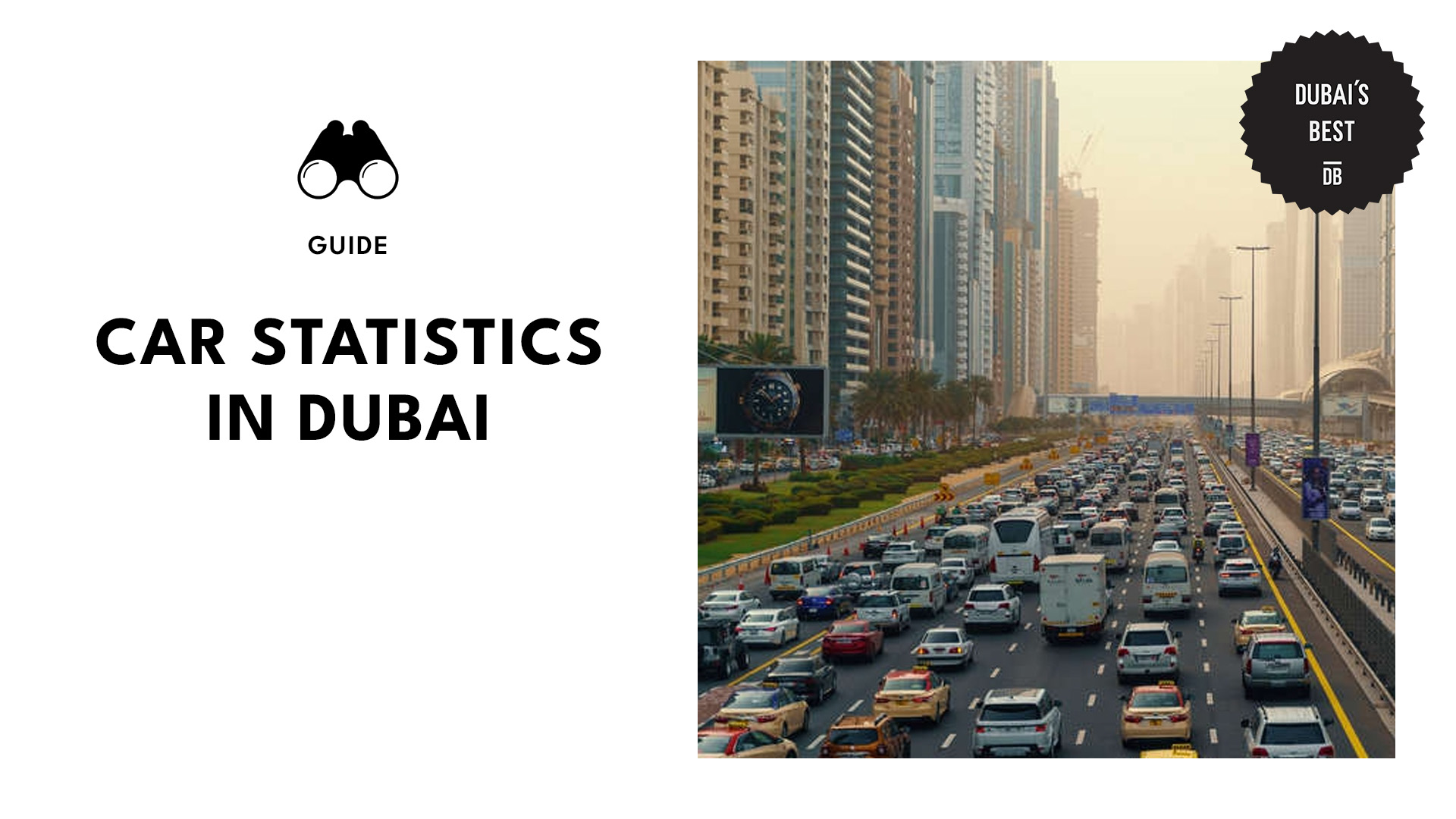Get Behind the Wheel and Zoom Through Dubai’s Car Statistics and Trends
Key Insights:
- Dubai has one of the highest car ownership rates globally, with 540 vehicles per 1,000 residents, far exceeding cities like New York and London.
- The number of registered vehicles grew over the years, from 740,000 in 2006 to 1.4 million in 2014 and 1.83 million in 2020.
- Peak daytime traffic sees 3.5 million vehicles on Dubai’s roads. Motorists lost an average of 35 hours in traffic in 2024.
- EV registrations surged by 262.4% in 2024, accounting for 6% of total car sales.
- Dubai is a hotspot for supercars, home to brands like Ferrari and Bugatti, and even features high-end police patrol cars.
- Dubai aims for 25% autonomous transport by 2030, expanded metro networks, and hyperloop technology for rapid travel. The UAE aims for electric and hybrid cars to comprise 50% of all vehicles by 2050.
Overview of Car Ownership in Dubai
Dubai has one of the highest car ownership rates in the world, with 540 vehicles per 1,000 residents, according to reports by the Roads and Transport Authority (RTA). This is equivalent to one car for every two people in the city.
In contrast, major cities like New York (305), London (213), Singapore (101), and Hong Kong (63) have significantly lower vehicle ownership rates. This reflects Dubai’s high-income population, luxury lifestyle, and strong preference for private transportation.
The number of registered vehicles in Dubai has surged over the years, from 740,000 in 2006 to 1.4 million by the end of 2014. In 2020, the total number of registered vehicles had reached 1.83 million.
According to the RTA as reported by Dubai Eye, the number of vehicles plying Dubai roads during the day had reached 3.5 million in 2023. A 10% increase in vehicle registrations had also been reported.
While car ownership remains integral to daily life, the government has invested heavily in public transportation, including the Dubai Metro, buses, and tram systems. These different modes of transport help reduce traffic congestion and enhance sustainability.
Compared to other global cities, Dubai’s infrastructure remains car-friendly. But as the population grows, balancing private vehicle use with efficient public transit will be crucial for long-term urban mobility.
Key Car Statistics in Dubai
Dubai’s car market continues to expand along with the adoption of more sustainable transport. As of 2023, Dubai’s vehicle registration reached 2,273,353. This reflected a 10% increase from 2022, according to data from the RTA.

During peak daytime hours, approximately 3.5 million vehicles traverse Dubai’s roads, underscoring the city’s heavy reliance on private transportation.
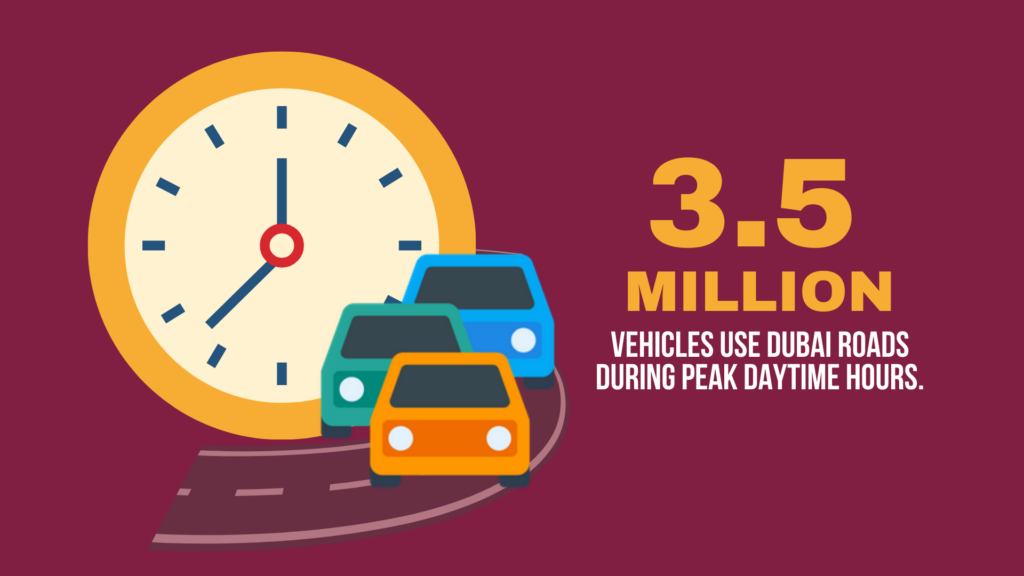
In 2023, Dubai registered over 47,000 green vehicles, aligning with the UAE’s goal for 50% of new cars to be green by 2050.
According to Focus2Move, the UAE’s electric vehicle market surged by 262.4% in 2024, accounting for 6% of total vehicle sales. Tesla led with 43% market share, surpassing Toyota, while BYD and MG gained ground.
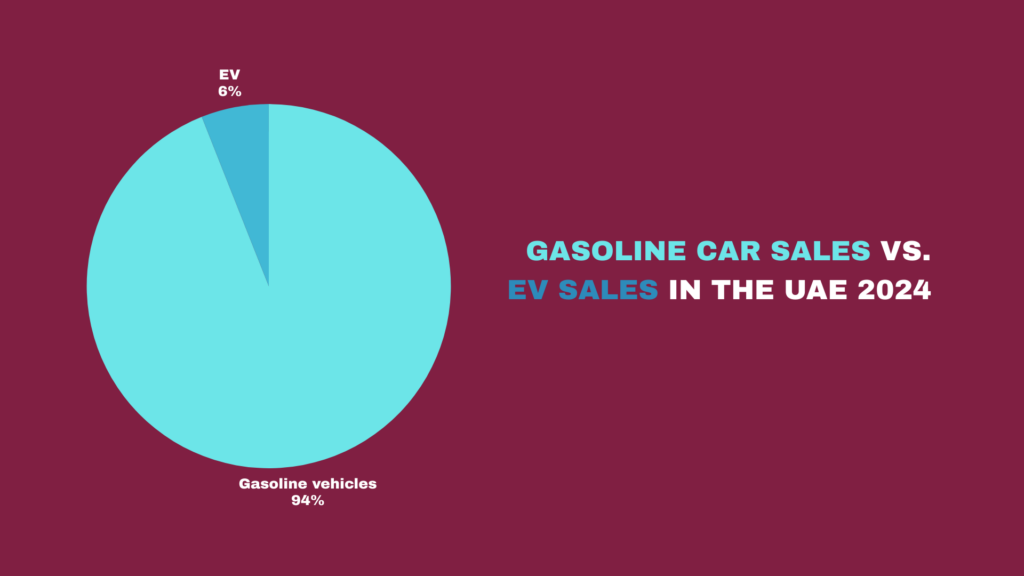
Meanwhile, the overall vehicle market in Dubai grew 19.1%, with Toyota, Nissan, and Mitsubishi leading. Across the United Arab Emirates, the total number of new registered motor vehicles reached over 259,000 based on data from Statista.

Luxury and Supercars in Dubai
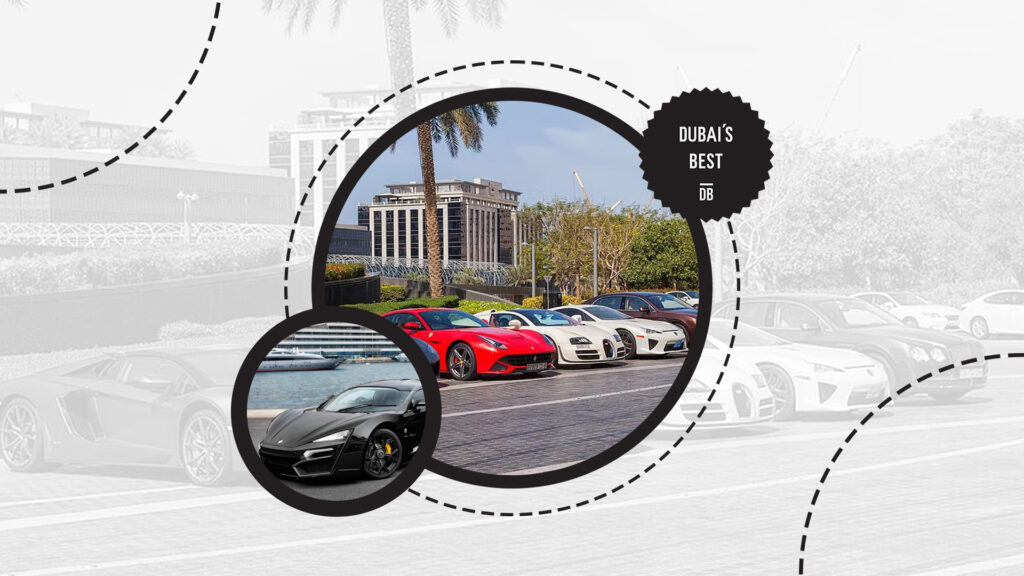
Dubai is renowned as a global hub for luxury cars and supercars, with brands like Ferrari, Lamborghini, Rolls Royce, and Bugatti dominating the streets.
The city’s affluent population and tax-free environment make it an ideal market for high-end vehicles, attracting collectors and enthusiasts from around the world.
Supercars account for a significant portion of vehicle import and sales in Dubai, with dealerships offering the latest models and custom-built hypercars.
Events like the Dubai International Motor Show further highlight the city’s passion for exotic automobiles, showcasing limited-edition and concept cars.
Dubai is also home to some of the most expensive cars ever spotted, including a $3.4 million dollar Lykan HyperSport, famously used in Fast & Furious 7.
Additionally, the Dubai Police fleet features luxury patrol cars like the Bugatti Veyron and Aston Martin One-77, making law enforcement in the city as stylish as it is efficient.
Car Usage and Patterns in Dubai
Daily Commutes
In 2023, private cars remained the dominant mode of transportation in Dubai, accounting for a significant portion of daily commutes.
Despite the availability of an extensive public transport network, many residents prefer the convenience and flexibility of personal vehicles. This preference contributes to increased traffic congestion, especially during peak hours.
Ride-Hailing Apps
Ride-hailing services, such as Careem and Uber, have emerged as popular alternatives to private car ownership. These offer residents and visitors flexible transportation options without the commitment of owning a vehicle.
These platforms have seen substantial growth, reflecting a shift towards on-demand mobility solutions.
Long-Distance Travel
For long-distance travel, Dubai’s well-developed highway infrastructure, notably Sheikh Zayed Road, facilitates seamless inter-emirate connectivity. This encourages the use of private cars for travel between emirates, further emphasizing the car-centric culture.
Public Transportation
In comparison, public transportation usage has been on the rise. In 2023, Dubai’s public transport network, including the metro, buses, trams, and marine transport, recorded approximately 702 million riders, marking a 13% increase from the previous year.
Despite this growth, the reliance on private cars remains substantial, highlighting the ongoing challenge of balancing personal vehicle use with public transport adoption to achieve sustainable urban mobility.
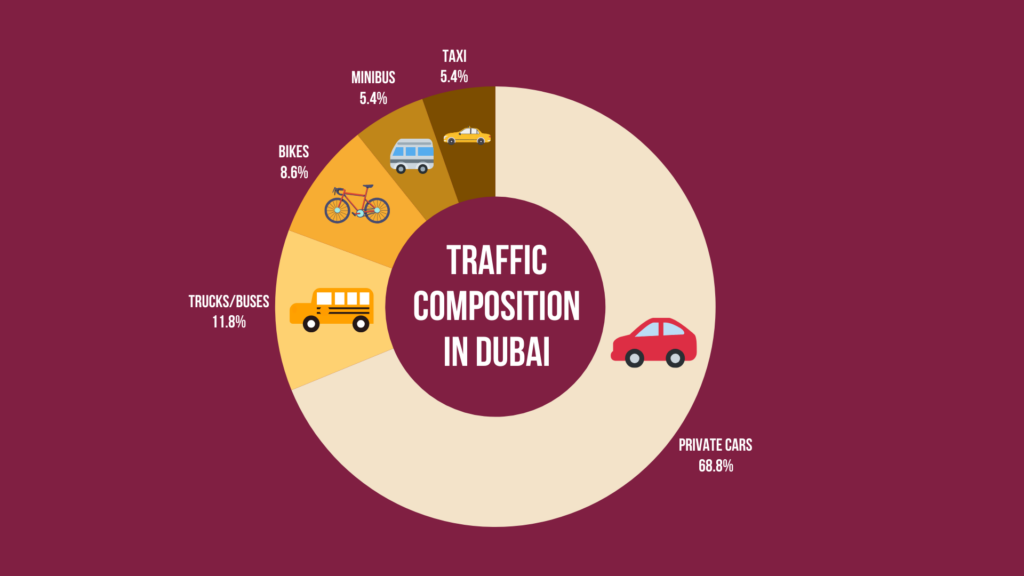
Environmental Impact of Cars in Dubai
Dubai’s high vehicle density contributes significantly to air pollution, with the transportation sector being a major source of carbon emissions.
To mitigate this environmental impact, the UAE government has implemented several initiatives to promote sustainable transportation.
Electric Vehicle (EV) Adoption
The number of electric vehicles has risen sharply as reported by CitaEV, reaching 25,929 by the end of December 2023, up from 15,100 in 2022. In 2024, the UAE’s electric vehicle sales increased by 262.4% or 6% of total vehicle sales.
This growth aligns with the UAE’s Green Mobility Strategy 2030, which aims for 30% of public sector vehicles and 10% of all vehicle sales to be electric or hybrid by 2030.
Government Incentives
To encourage EV adoption, the Dubai government offers various incentives. These include free public charging at Dubai Electricity and Water Authority (DEWA) stations and reduction or exemptions from parking fees in certain areas.
Green Mobility Strategy
This initiative promotes eco-friendly vehicles and aims to reduce the carbon footprint of the transportation sector. The strategy includes converting 50% of Dubai’s taxi fleet to hybrid vehicles, with plans to transition the entire fleet to hybrid and electric by 2027.
Car Import and Export Trends in Dubai
The city plays a key role in the global automotive trade, serving as a major hub for car imports and exports.
The city imports vehicles from leading manufacturers in Japan, Germany, China, and the USA, catering to high demand for SUVs, sedans, and luxury cars.
A significant portion of these imports is re-exported to GCC countries (The Gulf Cooperation Council) and Africa. Dubai’s strategic location and efficient logistics make it an ideal transit point.
The re-export market supports Dubai’s economy, with high-end and commercial vehicles in demand.
Here are the top countries in Dubai’s car trade:
| Category | Top Countries |
| Imports | Japan, USA, China, Germany, United Kingdom |
| Exports | Saudi Arabia, Oman, Jordan, Nigeria |
The Rise of Electric Vehicles in Dubai
The City of Gold has experienced a significant surge in electric vehicle (EV) adoption, aligning with its sustainability goals. By December 2023, the number of registered EVs in the city reached almost 26,000.
This growth is bolstered by DEWA’s EV Green Charge initiative, which recorded 1.15 million charging sessions in 2023 – a 59% increase compared to 2022.
The initiative provided 23.4 million MWh of electricity and supported a cumulative EV travel distance of 117 million kilometers.
To further promote EV adoption, the RTA offers incentives such as:
- Free parking
- Designated parking areas (painted green)
- Reduced registration fees
- Free Salik tags for Dubai-registered EVs
The city also aims to expand its network of public Green Charging Stations from 370 in 2023 to 1,000 by 2025.
Globally, EVs have been increasing, and Dubai’s proactive measures position it as a leader in the transition to sustainable transportation.
Here are some of the most popular EV models in Dubai:
- Tesla Model 3
- Audi e-tron
- BMW i4
- Nissan Leaf
- Porsche Taycan
- Hyundai Ioniq 5
- Kia EV6
- BYD Han
- Lucid Air
- Ford Mustang Mach-E
Traffic Congestion and Car-Related Challenges in Dubai
The rapid urbanization in Dubai has led to significant car-related challenges, notably traffic congestion, road accidents, and parking shortages.
According to Menafn.com, motorists experienced an average of 35 hours lost in traffic in 2024. This is a two-hour increase from the previous year, reflecting the growing strain on major thoroughfares like Sheikh Zayed Road and Al Khail Road.
Meanwhile, road safety remains a pressing concern. The UAE recorded 3,220 collision accidents in 2024, as reported by Gulf Today, with sudden swerving identified as the leading cause, accounting for 827 incidents.
In Dubai, lane discipline led to 80 out of 94 highway accidents in the first half of 2024.
Parking shortages exacerbate these issues, particularly in densely populated areas like Downtown Dubai and Dubai Marina.
In these areas, limited spaces lead to illegal parking and increased traffic disruptions. To address these issues, the Dubai government has initiated several measures:
- A notable AED 3.7 billion project aims to construct 634 kilometers of internal roads over five years to enhance traffic flow.
- RTA plans to expand the Dubai Metro network with the goal of doubling its stations by 2040 to alleviate congestion.
- Flexible work hours and remote work initiatives are also being considered to reduce peak-hour traffic.
These comprehensive strategies aim to mitigate car-related challenges, promoting a safer and more efficient urban environment in Dubai.
Dubai’s Vision for the Future of Cars and Transportation
Dubai is actively shaping the future of mobility with smart city initiatives aimed at reducing car dependency and embracing autonomous and electric vehicles.
The Dubai Autonomous Transportation Strategy aims for 25% of all trips to be driverless by 2030. This program will leverage AI-powered taxis, autonomous buses, and self-driving delivery vehicles.
The city is also expanding public transport, with the RTA planning to double Dubai Metro stations by 2040 and introduce more electric and hydrogen-powered buses.
Additionally, according to Wired Middle East, hyperloop technology is being explored to cut travel time between Dubai and Abu Dhabi to just 12 minutes.
To enhance sustainability, Dubai is investing in EV charging infrastructure and promoting shared mobility services.
With these innovations, the city is positioning itself as a global leader in smart and sustainable transportation. Ultimately, reducing traffic congestion and environmental impact while improving urban mobility.

